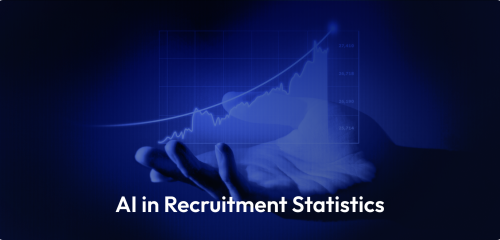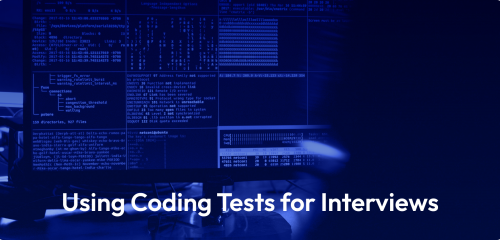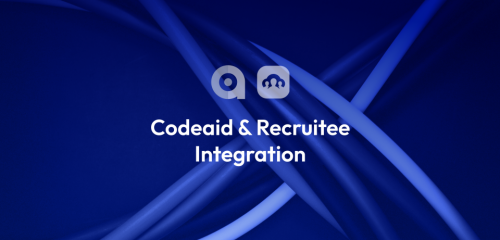It’s no secret that AI is revolutionizing every aspect of our lives, including HR management. It significantly improves many HR functions, especially when it comes to recruiting top talent and streamlining the hiring process.
From automating routine tasks to providing data-driven insights, AI is turning the HR landscape upside down. AI recruitment market trends also show a significant shift towards more companies adopting AI technologies in HR.
AI tools and solutions for recruiting talents are now critical in identifying the best candidates from a vast pool of applicants. In addition to testing candidates, AI is now used in training and testing current employees to help them hone new skills gained during their training.
In this guide, we will talk about how AI is changing the HR management game, including its benefits, processes, and trends.
Key takeaways
- AI in HR simply streamlines the recruitment process from many angles.
- Using AI tools in HR helps reduce biases, creating a faster and better testing / assessment process that is cheaper to operate.
- Balancing AI processes with human intuition is crucial for effective HR management.
- Integrating AI into your HR processes takes multiple steps, including planning and choosing the right tools, integrating it into your systems, training your employees, and keeping up with ongoing optimizations.
Understanding The Role of AI in Human Resource Management
We can share all the statistics in the world to prove that AI is revolutionizing HR, but you already know that. AI in HR makes traditional and menial tasks easier and faster to complete.
With human resources AI tools like Codeaid, you get the power to:
- Automate your technical interview process
- Automate interview scheduling
- Auto-generate interview questions for different positions
- Use AI chat for interviews
And this is just the tip of the iceberg. AI has the capacity to transform diverse factors in the recruitment process. When comparing AI to traditional interview processes, the differences are like day and night.
While traditional HR workflows rely on manual screenings and interview scheduling, modern AI-based HR tools speed up candidate selection, and even use predictive analytics to forecast staffing needs.
We will discuss the benefits of AI in the hiring process further in the next section of this guide.
Benefits of Integrating AI For HR Workflows
Building on the examples from the previous section, we will now delve deeper into how AI tools are transforming HR management.
Let’s explore the specific benefits of integrating AI into various HR functions, specifically the profound impact and advantages these technologies bring.
Improved recruitment processes
Traditional methods of recruitment often involve sifting through large volumes of resumes manually, which is not only labor-intensive but also prone to human error.
On the other side of the coin, AI tools are revolutionizing recruitment by automating time-consuming tasks and improving candidate selection processes.
- Initial screening with AI: AI-powered tools can quickly analyze thousands of CVs and identify the best candidates based on predefined criteria. This not only speeds up the whole hiring process but also makes sure you get a more objective and unbiased selection.
- AI interview tools: AI interviewers in HR can grade candidates more efficiently by analyzing their responses to provide a deeper insight into their suitability for the role.
Improved employee onboarding & offboarding processes
Onboarding and offboarding employees can take weeks or days if you’re lucky. That’s why another huge advantage of AI in HR is that it streamlines onboarding and offboarding processes, making them quicker and more personalized.
- Onboarding – AI can automate the onboarding process by giving new hires personalized training modules, schedules, and necessary documentation. This creates a smoother path for new employees, making them have a more seamless and engaging start in their new roles.
- Offboarding – We can reword this to say that it can help with generating insightful questions, taking some of that strain off the shoulders of HR managers. Alternatively, we can just remove the exit interview section and focus on how the systems help with filling out required forms and more technical things. This can include things like returning company equipment and filling out required forms. Ultimately, this tedious process becomes smoother for both organizations and employees.
Employee training & talent development
AI tools for human resources make training and development better by customizing the learning experience to individual employee needs. This way, the learning curve is made less steep because it is optimized for the person passing through it.
- Personalized learning: AI-backed platforms can assess employees’ skills and knowledge gaps and recommend training programs that are tailored to their specific needs and career goals.
- Continuous development: AI tools can provide ongoing assessments and feedback based on continuous monitoring. This eventually helps employees continuously improve and develop their skills.
At the end of the day, AI tools don’t only help the recruitment process but virtually every other aspect of managing your company’s human resources.
Performance review
AI tools for HR offer a more accurate and unbiased approach to performance reviews. Since there is minimal human factor involved in grading employees on their technical performance, the process is fair. Everyone is judged based on the same criteria.
- Objective assessments: AI can analyze an employee’s performance data over time (much longer and more attentively than an HR manager) to provide a more consistent and objective review. As opposed to traditional methods of performance reviews, AI HR software never relies on subjective judgments. Coupling this with human evaluations gives a balanced final result in the end.
- Data-driven feedback: Being powered by data gives AI the objective edge it needs to rate an employee’s skills and performance only. It generates data-driven insights that can help a manager give more constructive feedback and set achievable goals for their team members.
Employee retention & engagement
Turnover is never something HR managers want to boost. This is where AI comes in to eliminate traditional methods that no longer work. Ultimately, AI plays a huge role in improving the retention of employees and boosting their overall engagement. This is done thanks to the AI’s ability to precisely identify potential pain points and their solutions.
- Predictive analytics: AI can analyze employee data to measure and predict turnover risks, giving a heads up to HR teams to address potential problems before they turn into resignations.
- Engagement tools: AI can help keep your employees engaged and satisfied. It can measure these metrics through monthly or weekly sentiment surveys, and in case of worrisome results, recommend HR managers to hold 1-1s and find a resolution.
AI chatbots & virtual assistants
We’re already familiar with AI chatbots like ChatGPT, Google Gemini, and Bing AI. Did you know that their power in HR management is on the rise as well? AI chatbots and virtual assistants make HR operations better by delivering immediate support and boosting the efficiency of workflows.
Ultimately, your employees get instant answers to any questions that arise, thereby minimizing their downtime and eliminating any bottlenecks.
- Routine handling of queries: AI chatbots can manage day-to-day queries from employees and potential candidates. This can include anything from company policy to application statuses. At the end of the day, you free up the pressure from your HR professionals so that they can focus on more complex tasks. Nevertheless, this technology isn’t perfect and still needs to evolve into a system that recognizes tasks too complex for it to handle, establishing appropriate hand-off triggers.
- Scheduling and logistics: Virtual assistants in HR management can handle scheduling for interviews, meetings, and other similar activities. This way, these tasks are streamlined and automated with the process of AI interviews.
Considering all of these advantages, it becomes clear that AI Recruitment tools are a great investment. But how can you integrate them into your existing workflows? Let’s move on to the next section to understand the process.
Understanding the Process of Integrating AI Tools For Your HR Workflows
If we’ve convinced you that AI tools for human resources are worth your while and you’re considering implementing it for your company, let us tell you the details of this process.
You’re looking at optimizing your operations, improving your internal decision-making processes, and simply boosting the effectiveness of your HR functions.
We’ve put together a step-by-step guide to using AI for recruitment processes below, including planning, choosing the right tool, and maintaining its efficiency.
Step 1: Define the Purpose, Conduct Research, and Identify Your HR Objectives
If you fail to plan, you are planning to fail. This is why this first step is crucial when implementing AI for HR solutions. To set a solid foundation upon which you can experience exponential growth, you need to start by defining the purpose of your AI tool.
What specific processes are you looking to automate? Are you aiming to use it only during recruitment or for boosting employee engagement and more? These are all questions that need to be answered before diving into the deep end.
Next, you will need to research the available options to solve your designated problems.
Lastly, you’ll need to set clear and measurable goals for your AI integration process. Possible goals can be:
- Reducing your time-to-hire
- Increasing your employee retention
- Automating routine tasks
Step 2: Evaluate and Analyze Your Existing HR Management Workflow
With step 2, you need to assess the current situation of your HR workflows. After all, once you identify the problem, you are halfway there to solving it.
So, start by identifying the areas where you can experience the most benefit from AI. This can include processes like recruitment, onboarding, employee training, etc.
Once you have a clear picture, you should start looking for gaps in your workflow. Where are your bottlenecks hiding? If you find that your recruitment process is too long and resource-intensive, you’ll know to look for an AI tool that can help you streamline it.
Next, you’ll need to set the right foundation and make sure that your company is ready to adopt this new technology. Prepare your technology infrastructure (e.g., give your employees access to any necessary software) and help your staff to become willing to accept AI (e.g., introduce them to AI, hold a training course about the ways AI can help them become more efficient).
Step 3: Choosing The Right AI Tools for Your HR Solutions
With the hundreds of AI solutions out there, it can be hard to find your match. On top of that, traditional HRMS applications out there aren’t standing still. They are also adding AI functionality to their tools to stay in the game.
Remember that you’ll need to align your goals with the gaps in your workflows. Aside from that, here are a couple of features you should prioritize for a smoother integration:
- Ease of use
- Scalability
- Integration capabilities with existing systems
Once you find the perfect AI tool for your HR needs, don’t rush into the integration process. Start with a pilot test. Evaluate their effectiveness in situations that your company encounters often. Usually, AI tools will offer a free trial or demo. Make use of them and test them out.
Do your employees enjoy the tool? Can it help you achieve your goals? If the answer to such questions is positive, you can push the red button and start your full-scale implementation.
Step 4: Train and Educate Your HR Team
Before you can start seeing results from your AI tool, you’ll need to train your staff and learn the ways of the software. If you’ve chosen a good partner, this process will be easier.
Start by implementing a comprehensive training program within your HR team to introduce them to the tool. Ultimately, they need to know how to use each and every beneficial feature it comes with.
After that, you should also create a systematic workflow to provide ongoing support and training to your HR managers. Keep them updated with the latest AI tech and best practices to see the best possible results.
Step 5: Implement and Integrate AI Tools into Your HR Workflow
Now that you’re close to the finish line, you’ll need to come up with a detailed implementation plan. Outline all timelines, milestones, responsible personnel, and more. Following this plan will ensure that you have a smoother transition.
Next, you’ll start integrating your new and shiny AI tool into your existing HR system. Depending on the scale of the tool, you might need to work with your IT department to hash out any technical issues.
Step 6: Monitor and Optimize to Ensure Maximum Efficiency
Once all is said and done, all you have to do is maintain and optimize your upgraded workflows. Check in after 1 month and assess whether or not the AI tools are helping you reach your goals.
To monitor your performance effectively, you can measure metrics things like:
- Time-to-hire
- Employee satisfaction
- Cost savings
If everything looks good there, you can start thinking about optimizing the tools to get even better performance. From new features to updated training materials, there’s a lot you can do to keep growing.
This 6-step guide is a framework that can power your adaptation to new HR AI tools. Within a couple of months, your HR department will become better, more data-driven, and proactive.
While AI tools are rapidly evolving, we’re excited to see all the new features and capabilities it will be able to support soon.
Emerging Trends in AI Tools for Human Resources
As we look into the future of artificial intelligence in human resources, we see that it has major significance. When it comes to recruiting and managing talent, AI has tons of benefits in terms of attracting, retaining, and growing workforces.
In fact, 67% of companies that have already implemented such tools into their talent acquisition processes report experiencing cost and resource savings.
To wrap up this guide, let’s talk about some trends that are on the horizon.
Advanced candidate matching
First things first, we look forward to seeing more intelligent candidate matching that covers more bases, including cultural fits and experience. While AI can help in recruitment today, it still has a lot of potential for growth in terms of helping you find the perfect fit.
Predictive analytics
Imagine being able to forecast your organization’s future hiring needs and start the recruiting process in a proactive rather than reactive way. With the way things are going, AI can eventually achieve that level of effectiveness.
Automated interview questionnaire generation
One of the most useful features of AI-powered hiring tools is the creation of interview questions based on the skills and positions you are hiring for. For example, Codeaid’s AI Interviewer tool can create tests with multiple choice, free text, coding, and even code review questions.
We truly believe that modern HR management is simply made better with AI tools. That’s why we look forward to seeing more and more companies transforming more stages of their recruitment processes toward more dynamic and responsive operations with AI.
Conclusion
We are finally at the finish line folks. Now, there is no doubt that AI is bringing a significant transformation to HR. With faster and better recruiting, better employee retention, and even automated performance reviews, AI seems to be on the right track.
By embracing these AI advancements, HR professionals and companies can boost their operations and achieve even better outcomes in talent acquisition and management.
Codeaid’s AI solutions are designed to support HR teams in achieving these goals. With tools like our AI Interviewer and comprehensive Coding Test Assessment, we provide innovative tools that help organizations streamline their HR functions and make data-driven decisions.
Ready to experience the benefits of AI in HR?
FAQ
How long does it take to integrate AI tools into My HR Workflow? The time required to integrate AI tools into your HR workflow can vary depending on the complexity of your existing systems and the specific AI tool you choose to implement.
Usually, it can take anywhere from a few hours to a few weeks for more complex systems. With Codeaid, you can be up and running within a couple of hours. After that, you’ll be able to create interviews and invite candidates in minutes.
What type of training is required for HR professionals to effectively use AI tools? Generally, HR professionals would need to be introduced to AI concepts. After that, they will be able to learn how to operate a specific AI tool. At the end, they can be trained on the best practices for AI tool interpretation and data management.
Such training can be done through hands-on sessions and real-life examples. Lastly, remember that practice makes perfect.
What are the common issues that might arise when using AI tools in HR management, and how can they be resolved? Depending on the AI software you choose, you might encounter different types of issues. More common issues include technical challenges during integration. Less common examples can be data privacy issues, which can be solved through security measures.
How can HR ensure that artificial intelligence is balanced to avoid bias? AI software for HR management is known to remove human bias from the recruitment process. However, if you are concerned about biases within training data sets of AI, it all comes down to regular checks and a reliable partner like Codeaid.
Are there any other technical requirements necessary for AI integration in HR? It all depends on the tool you choose to implement. Usually, complex software requires a robust data infrastructure for effective integration. However, with AI-powered interviewer tools like Codeaid, you won’t have to worry about technical requirements.
Does Codeaid Offer Ongoing Support for Their AI Interviewer tool? Of course! We want to give our clients the best possible experience, which is why we deliver ongoing support and updates. New features are being released frequently, and our support team is always here to resolve potential issues.



